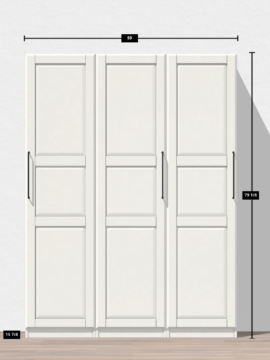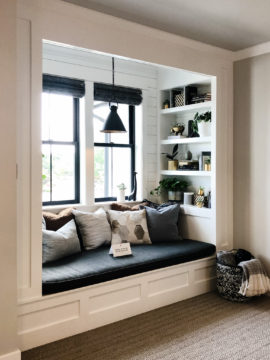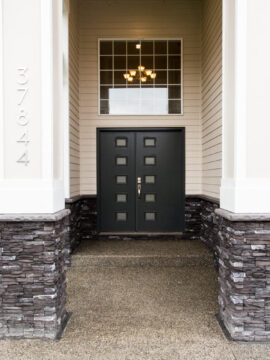In this post, I will share about garage floor epoxy coating, and how to apply it. Also will compare Rust-Oleum Epoxy Shield and Rust-Oleum Rocksolid. If you are deciding between Epoxy Shield and Rocksolid, read on for the pros and cons of both.
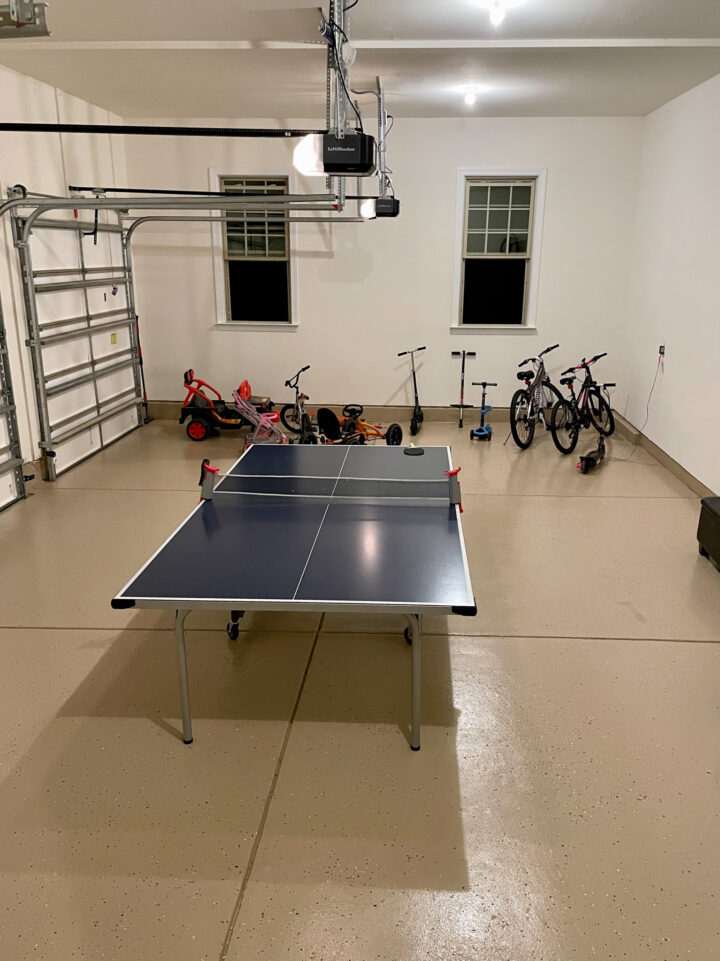
Table of Contents
What is epoxy flooring for a garage?
Epoxy flooring for a garage is a type of floor coating, a garage floor paint so to speak, that is made by combining resin and hardener to create a durable, long-lasting surface. This type of flooring is commonly used in residential garages because it can withstand heavy use, is resistant to stains and chemicals, and can be easily cleaned.
Epoxy flooring can be applied to concrete floors, which is commonly found in garages, and it creates a smooth, glossy finish that is easy to maintain. The coating also helps to protect the concrete from damage caused by spills, impacts, and abrasions.
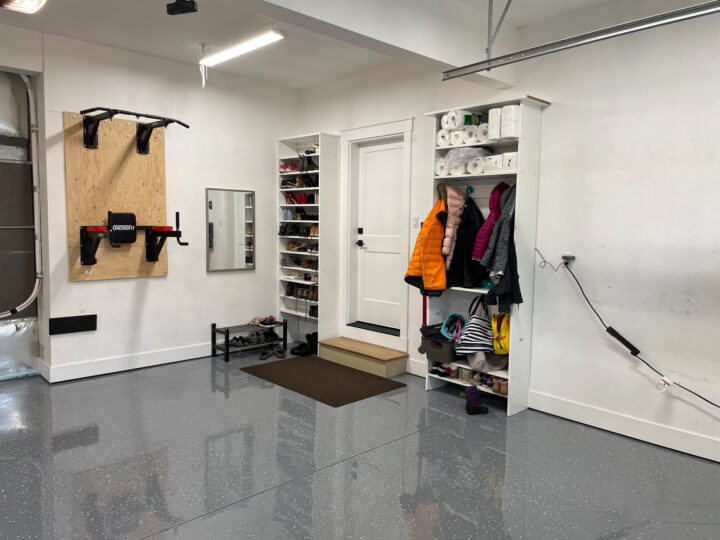
In addition to its practical benefits, the epoxy-finished floor can also enhance the appearance of the space. It is available in a variety of colors and finishes, including metallic and flake designs, allowing homeowners to customize the look of their garage.
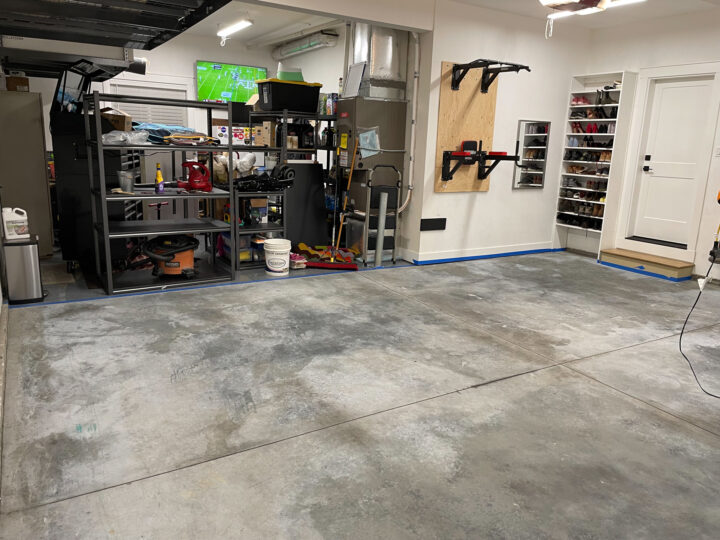
7 Steps How to Turn Your Builder-Grade Home into a Custom Home
How to keep your design cohesive when remodeling a home
Is epoxy flooring toxic?
Epoxy flooring, like most construction materials, can be toxic if not handled properly. The primary health hazard associated with epoxy flooring is the fumes that are released during the installation process. The fumes can cause respiratory irritation, headaches, and dizziness, particularly in individuals with asthma or other respiratory conditions.
However, once the epoxy flooring has cured, it is generally considered to be non-toxic. The epoxy resin and hardener react chemically during the curing process to form a solid, inert material. As long as the epoxy flooring is properly installed and cured, there is little risk of toxicity.
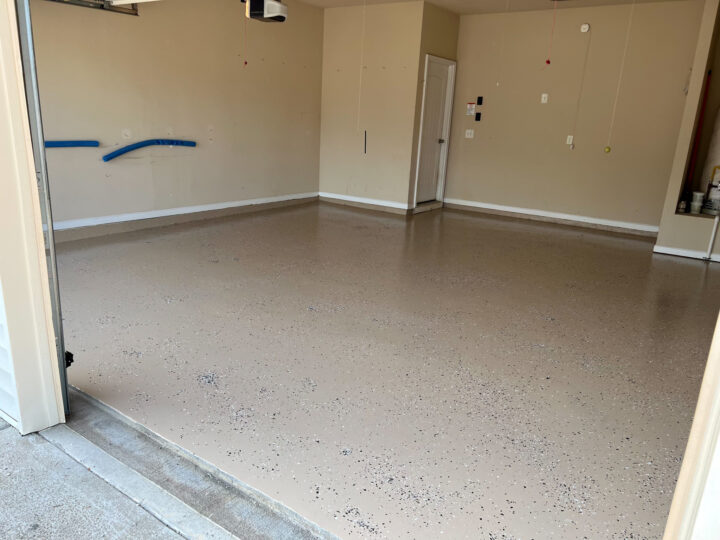
How long does the epoxy floor last in the garage?
The lifespan of an epoxy floor in a garage can vary depending on a variety of factors, such as the quality of the epoxy product, the amount of traffic the floor sees, and the level of maintenance it receives. Generally speaking, a well-installed and properly maintained epoxy floor can last for 5 to 10 years or more in a garage.
Are epoxy garage floors durable?
Factors that can affect the longevity of an epoxy floor in a garage include:
- Quality of the epoxy product: High-quality epoxy products will typically last longer than cheaper, lower-quality products.
- Amount of traffic: The more foot and vehicle traffic the floor sees, the more quickly it will wear down.
- Chemical exposure: Epoxy floors are resistant to many chemicals, but exposure to certain chemicals can cause damage and shorten the lifespan of the floor.
- Level of maintenance: Regular cleaning and maintenance can help extend the life of an epoxy floor.
To ensure the longest possible lifespan for an epoxy floor in a garage, it’s important to choose a high-quality product, follow proper installation procedures, and maintain the floor regularly.
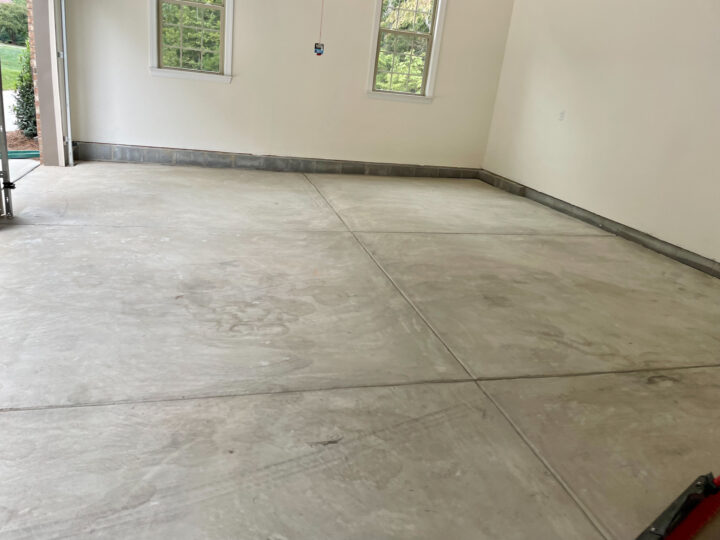
When is the best time to epoxy the garage floor?
The best time to epoxy a garage floor is when the weather conditions are optimal for the epoxy to cure and bond properly. Ideally, the temperature should be between 60-90°F (15-32°C) with low humidity levels, and there should be no rain or snow in the forecast.
Additionally, it’s important to prepare the garage floor properly before applying the epoxy. This includes cleaning the surface thoroughly, repairing any cracks or damage, and etching the surface to promote adhesion.
The time of day when you apply the epoxy can also make a difference. It’s best to apply the epoxy when the garage is shaded and the temperature is not at its peak, such as early in the morning or late in the afternoon. This can help prevent the epoxy from drying too quickly or bubbling.
In summary, the best time to epoxy a garage floor is during a period of moderate temperature and low humidity, with no rain or snow in the forecast. It’s also important to properly prepare the surface and apply the epoxy during a time of day when the temperature is not at its peak.
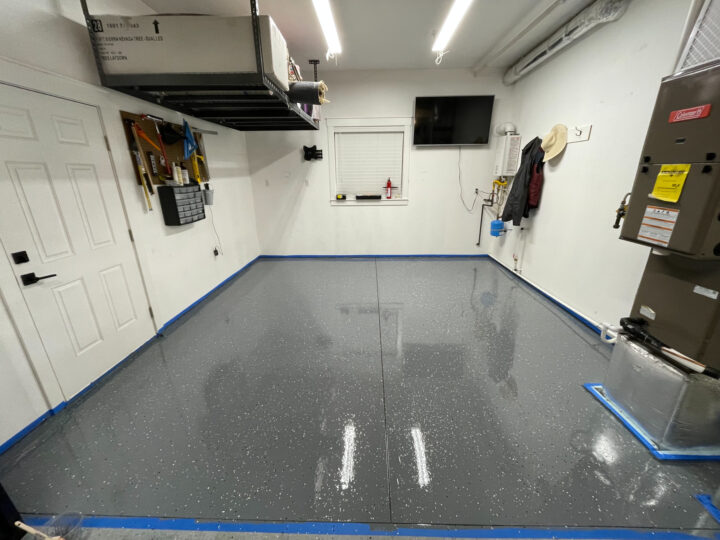
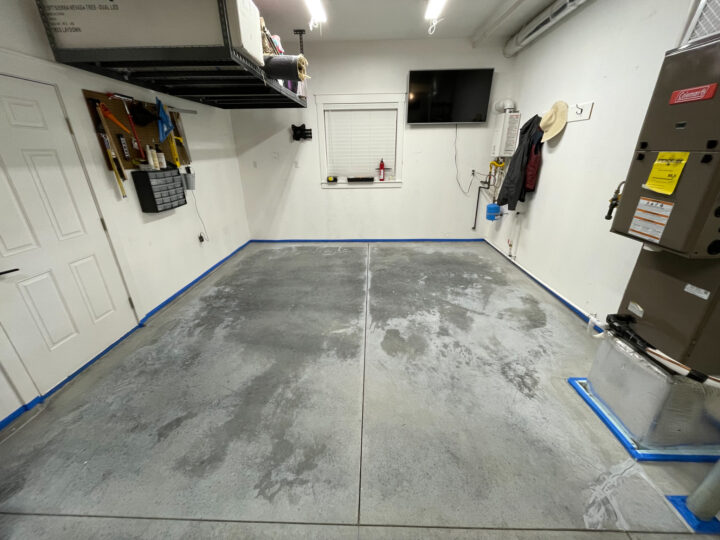
Which garage floor is best?
When it comes to selecting the best garage floor, there are several options available, each with its own benefits and drawbacks. Here are some of the most popular options:
- Epoxy flooring: Epoxy flooring is a popular choice for garages because it is durable, easy to clean, and resistant to stains and chemicals. Epoxy floors can also be customized with different colors and finishes.
- Concrete staining: Concrete staining is another option for garage floors. Staining can give concrete floors a unique, decorative look, and can be combined with other techniques like scoring and stenciling.
- Interlocking tiles: Interlocking tiles are a quick and easy way to update a garage floor. They are easy to install and can be customized with different colors and patterns.
- Vinyl flooring: Vinyl flooring is another durable and easy-to-clean option for garage floors. It comes in a variety of styles and can be installed easily over existing flooring.
The best garage floor option for you will depend on your specific needs and preferences. Epoxy flooring is a popular choice because of its durability and versatility, but other options like concrete staining and interlocking tiles can offer unique design possibilities. Consider your budget, maintenance requirements, and aesthetic preferences when selecting the best garage floor for your needs.
Where to buy epoxy for the garage floor?
Rust-Oleum is a popular brand of garage epoxy, they offer complete epoxy floor kits. They have many color choices and offer a warranty against hot tire pickup. It’s sold at Home Depot, Amazon, and other retailers.
Rust-Oleum 317284 Rocksolid Polycuramine Garage Oil Floor Coating, 2.5 Car Kit, Dark Gray
Rust-Oleum 261845 EpoxyShield Garage Floor Coating , 2 gal, Gray
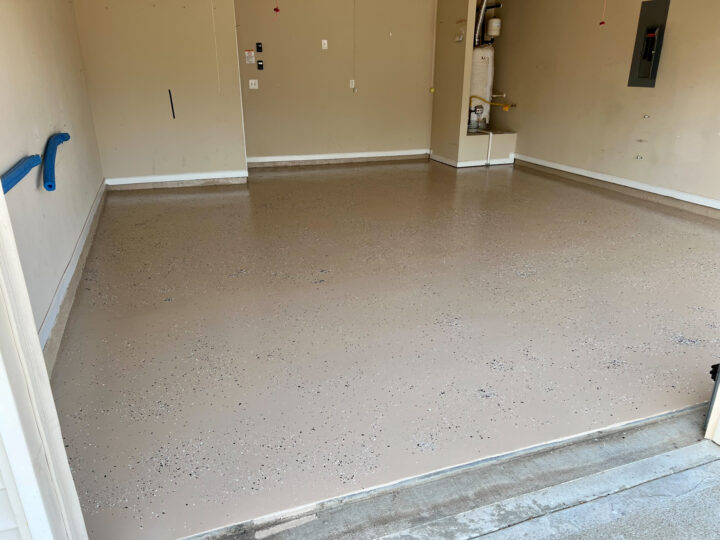
Application epoxy coating
The best part about buying an epoxy kit is that it provides everything you need to DIY an epoxy garage floor.
- Prepare for the project: Read the full instructions before starting the project to make sure you have everything ready.
- Prepare the surface: The surface should be clean, dry, and free of any grease, oil spots, or loose particles. If necessary, sand the surface lightly to ensure proper adhesion.
- Prime the surface (optional): For best results, Rust-Oleum recommends applying a primer before painting. The primer will help the paint adhere better and ensure a smooth finish.
- Apply the Rust-Oleum coating: Use a paintbrush to trim the outer edges, then a roller to apply the coating in thin, even coats. Apply the decorative color chips while the floor is still wet. Be sure to follow the manufacturer’s instructions for application and drying times.
- Application tip: If your garage is too big for your DIY application or if you need to store something inside the garage and cannot paint the entire floor at one time, you can divide the garage floor into sections and apply it to one section, let it dry completely and then finish the rest of the floor.
- Apply additional coats (if necessary): Depending on the type of coating and the desired finish, you may need to apply multiple coats. We only applied one coat in our projects. Make sure you allow each coat to dry completely before applying the next.
- Clean up: Clean up any tools or equipment used for application with soap and water or the recommended cleaning solution for the product.
Rust-Oleum epoxy shield vs RockSolid
Both Rust-Oleum Epoxy Shield and RockSolid are popular brands of epoxy coatings that are used for garage floors, concrete surfaces, and other high-traffic areas. Here are some differences between the two products:
- Drying time: Rust-Oleum Epoxy Shield has a longer drying time of at least 24 hours before it can be walked on, while RockSolid can be walked on within 8-10 hours.
- Durability: Both products are durable and resistant to chemicals, stains, and abrasion, but RockSolid is marketed as being up to 20 times stronger than epoxy.
- Appearance: Both products offer a range of color options and finishes, but the RockSolid line includes metallic and decorative options that Rust-Oleum Epoxy Shield does not. RockSolid has a glossy finish and it gives it a more professional appearance.
- Practical use: RockSolid is very slippery when wet and is better recommended for dry climates. Because it seals the concrete, the puddles can stay on the floor for days.
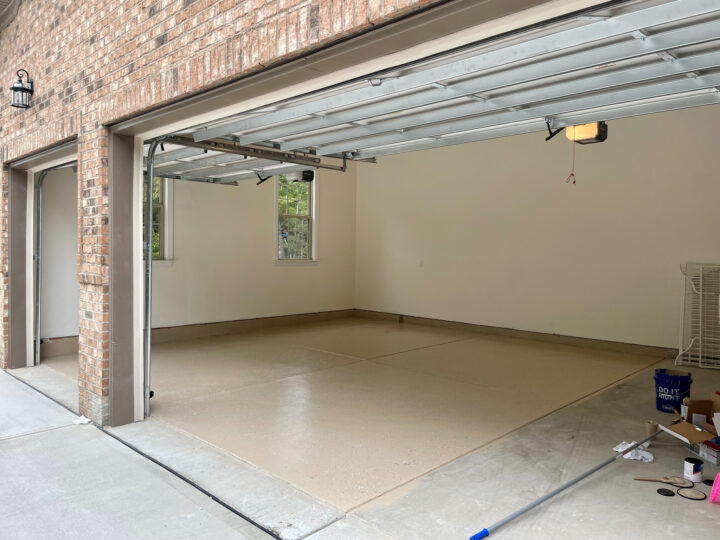
Is epoxy flooring slippery?
Epoxy flooring can be slippery when it is wet, especially if the surface is smooth and polished. This is because the epoxy creates a smooth and non-porous surface that can become slippery when it is wet. However, there are ways to reduce the slipperiness of epoxy flooring:
- Add a non-slip additive: There are non-slip additives that can be mixed into the epoxy coating during application. These additives will help create a rougher surface texture that is less likely to be slippery.
- Choose a textured finish: Instead of a smooth, polished finish, consider a textured finish that will provide more grip. This can include finishes like a sandpaper texture or a pebbled texture.
- Use floor mats: Floor mats or rugs can be placed in areas where slipperiness is a concern, such as near entryways or areas where water may accumulate.
It’s important to note that even with these precautions, epoxy flooring may still be slippery when wet. Therefore, it’s important to exercise caution when walking on wet surfaces and consider adding additional non-slip measures if needed.
Conclusion
Epoxy flooring is commonly chosen for residential garage floors due to its ability to shield the concrete from harm caused by spills, impacts, and abrasions.
How to paint a room step by step (beginner guide)
5 Ways to Renovate Your Kitchen on a budget
Discover more from Your Designer BFF
Subscribe to get the latest posts sent to your email.

